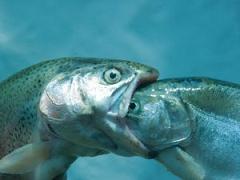Dynamic Architecture of Biological Networks: Difference between revisions
From Santa Fe Institute Events Wiki
(New page: {{CSSS 2010 Santa Fe}} Image:fish.jpg Next meeting... when? Members/interested: * Jonathan Cannon * Gavin Fay * Vanessa Weinberger * Borys Wrobel * Andrew Hein ...) |
No edit summary |
||
| Line 2: | Line 2: | ||
[[Image:fish.jpg]] | [[Image:fish.jpg]] | ||
Members: | |||
Members | |||
* [[Jonathan Cannon]] | * [[Jonathan Cannon]] | ||
* [[Gavin Fay]] | * [[Gavin Fay]] | ||
* [[Vanessa Weinberger]] | * [[Vanessa Weinberger]] | ||
* [[Andrew Hein]] | * [[Andrew Hein]] | ||
In food webs, predation dynamics effect populations over the short time scale, but also affects network structure in the long term by the mechanism of extinction. Conversely, the couplings represented by the network structure constrain the short-term predation dynamics. | |||
As new species are gradually introduced into a model food web, the network architecture and network dynamics interact, sometimes leading to large stable feeding networks and sometimes to massive extinction events. We are designing simulations to study the characteristic properties of stable, longitudinally-constructed food webs and the nature of the events that stabilize or destabilize them. | |||
Latest revision as of 08:44, 25 June 2010
| CSSS Santa Fe 2010 |
Members:
In food webs, predation dynamics effect populations over the short time scale, but also affects network structure in the long term by the mechanism of extinction. Conversely, the couplings represented by the network structure constrain the short-term predation dynamics.
As new species are gradually introduced into a model food web, the network architecture and network dynamics interact, sometimes leading to large stable feeding networks and sometimes to massive extinction events. We are designing simulations to study the characteristic properties of stable, longitudinally-constructed food webs and the nature of the events that stabilize or destabilize them.

